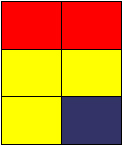|
|
|
1.
|
Use the diagram below to answer the following questions.
 Which
fraction represents the red area of this diagram?
|
|
|
2.
|
Select the fraction that is equivalent to the red area in the diagram.
|
|
|
3.
|
Which fraction represents the yellow area of the diagram?
|
|
|
4.
|
Select the fraction that is equivalent to the yellow area in the diagram.
|
|
|
5.
|
Which fraction represents the blue area of the diagram?
|
|
|
6.
|
Choose the fraction that is equivalent to the blue area in the diagram.
|
|
|
7.
|
Use the diagram below to answer the following questions.
 Which fraction represents the blue
area of this diagram?
|
|
|
8.
|
Select the fraction that is equivalent to the blue area in the diagram.
|
|
|
9.
|
Which fraction represents the yellow area in the diagram?
|
|
|
10.
|
Select the fraction that is equivalent to the yellow area in the diagram.
|